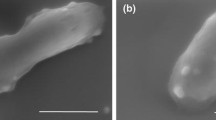Abstract
Twelve strains of algicidal bacteria were isolated from the surfacewater of the pond Shinobazu and the moat Ote-bori (Tokyo, Japan). Nine of thesestrains were considered to be in the Pseudomonas group byanalyses of 16S rDNA sequences. The methanol extract ofPseudomonas sp. K44-1 showed marked antialgal activity bythe paper disk method. Harmane (1-methyl-β-carboline) was isolated fromtheethyl acetate extract of the whole culture broth ofPseudomonas sp. K44-1 by using silica gel columnchromatography and high performance liquid chromatography (HPLC). Harmaneshowedantagonistic activities against several cyanobacterial strains at aconcentration of 30 μg disk−1.
Similar content being viewed by others
References
Allen J.R.F. and Holmstedt B.R. 1980. The simple β-carboline alkaloids. Phytochemistry: 1573-1582.
Bohlendorf B., Forche E., Bedorf N., Gerth K., Irschik H., Jansen R. et al. 1996. Indole and quinoline derivatives as metabolites of tryptophan in myxobacteria. Liebigs Annalen 1: 49-53.
Carmichael W.W. 1992. A status report of planktonic cyanobacteria (Blue-green algae and their toxins.). #EPA/600/R-92/079. United States Environmental Protection Agency, Washington, DC, USA.
Cheng J. and Mitchelson K.R. 1997. Improved separation of six harmane alkaloids by high-performance capillary electrophoresis. J. Chromatogr. 761: 297-305.
Dakhama A., Noue J. and Lavoie M.C. 1993. Isolation and identi-fication of antialgal substances produced by Pseudomonas aeruginosa. J. appl. Phycol. 5: 297-306.
Harada K.-I. 1996. Chemistry and detection of microcystins. In: Watanabe M.F., Harada K.-I., Carmichael W.W. and Fujiki H. (eds), Toxic Microcystis. CRC Press, pp. 103-148.
Kikuchi T., Miura T., Harimaya K., Yano H., Arimoto T., Masada Y. et al. 1973. Odorous metabolites of blue-green alga: Schizothrix muelleri Nägeli collected in the southern basin of Lake Biwa. Identification of geosmin. Chem. Pharm Bull. 21: 2342- 2343.
Kimura M. 1980. A simple method for estimating evolutionary rates of base substitutions through comparative studies of nucleotide sequences. J. Mol. Evol. 16: 111-120.
Mitsutani A., Uchida A. and Ishida Y. 1987. Occurrence of bluegreen algae and algal lytic bacteria in Lake Biwa. Bull. Jap.Soc. Microbiol. Ecol. 2: 21-28.
Neefs J.M., Van de Peer Y., Hendriks L. and Watcher R. 1990. Compilation of small ribosomal subunit RNA sequences. Nucleic Acids Res. 18: 2237-2317.
Palmer C.M. and Maloney T.E. 1955. Preliminary screening for potential algicides. Ohio J. Sci. 55: 1-8.
Rashidan K.K. and Bird D.F. 2000. Role of predatory bacteria in the termination of a cyanobacterial bloom. Microb. Ecol. 16: 97-105.
Reim R.L., Shane M.S. and Cannon R.E. 1974. The characterization of a Bacillus capable of blue-green bactericidal activity. Can. J. Microbiol. 20: 981-986.
Safferman R.S. and Morris M.E. 1962. Evaluation of natural products for algicidal properties. Appl. Microbiol. 10: 289-292.
Saitou N. and Nei M. 1987. The neighbor-joining method: a new method for reconstructing phylogenetic trees. Mol. Biol. Evol. 4: 406-425.
Takeuchi T., Ogawa K., Iinuma H., Suda H., Ukita K., Nagamatsu T. et al. 1973. Monoamine oxidase inhibitors isolated from fermented broths. J. Antibiot. 16: 162-177.
Takase S. and Murakami H. 1966. Studies on the fluorescence of Saké. I. Fluorescence spectrum of Saké and identification of harmane. Agr. Biol. Chem. 30: 869-876.
Thompson J.D., Higgin D.G. and Gibson T.J. 1994. CLUSTALW: improving the sensitivity of progressive multiple sequence alignment through sequence weighting, positions-specific gap penalties and weight matrix choice. Nucleic Acids Res. 22:4673-4680.
Tsuchiya Y., Watanabe M.F. and Watanabe M. 1992. Volatile organic sulfur compounds associated with blue-green algae from inland waters of Japan. Wat. Sci. Technol. 25: 123-130.
Watanabe M.M., Kawauchi M., Hiroki M. and Kasai F. 2000. NIES-Collection, List of Strains, Microalgae and Protozoa; Microbial Culture Collection. National Institute for Environmental Science, Japan, 30-32.
Yamamoto Y. 1978. Detection of algal lysing biological agents in lakes by the soft-agar overlayer technique. Jap. J. Limnol. 39: 9-14.
Yamamoto Y., Kouchiwa T., Hodoki Y., Hotta K., Uchida H. and Harada K.-I. 1998. Distribution and identification of actinomycetes lysing cyanobacteria in a eutrophic lake. J. Appl. Phycol. 10: 391-397.
Yamamoto Y., Niizuma S., Kuroda N. and Sakamoto M. 1993. Occurrence of heterotrophic bacteria causing lysis of cyanobacteria in a eutrophic lake. Jap. J. Phycol. 41: 215-220.
Yoshikawa K., Adachi K., Nishijima M., Takadera T., Tamaki S., Harada K.-I. et al. 2000. β-Cyanoalanine production by marine bacteria on cyanide-free medium and its specific inhibitory activity toward cyanobacteria. Appl. Environ. Microbiol. 66: 718-722.
Author information
Authors and Affiliations
Rights and permissions
About this article
Cite this article
Kodani, S., Imoto, A., Mitsutani, A. et al. Isolation and identification of the antialgal compound, harmane (1-methyl-β-carboline), produced by the algicidal bacterium, Pseudomonas sp. K44-1. Journal of Applied Phycology 14, 109–114 (2002). https://doi.org/10.1023/A:1019533414018
Issue Date:
DOI: https://doi.org/10.1023/A:1019533414018




